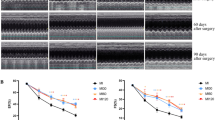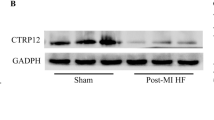Abstract
Inflammation has been implicated in myocardial infarction (MI). MDM2 associates with nuclear factor-κB (NF-κB)-mediated inflammation. However, the role of MDM2 in MI remains unclear. This study aimed to evaluate the impacts of MDM2 inhibition on cardiac dysfunction and fibrosis after experimental MI and the underlying mechanisms. Three-month-old male C57BL/6 mice were subjected to left anterior descending (LAD) coronary artery ligation for induction of myocardial infarction (MI). Immediately after MI induction, mice were treated with Nutlin-3a (100 mg/kg) or vehicle twice daily for 4 weeks. Survival, heart function and fibrosis were assessed. Signaling molecules were detected by Western blotting. Mouse myofibroblasts under oxygen and glucose deprivation were used for in vitro experiments. MDM2 protein expression was significantly elevated in the mouse heart after MI. Compared with vehicle-treated animals, Nutlin-3a treatment reduced the mouse mortality. Nutlin-3a treatment improved heart function and decreased the infarct scar and fibrosis compared with vehicle. Furthermore, MDM2 inhibition restored IκB and inhibited NF-κB activation, leading to suppressed production of proinflammatory cytokines in the heart after MI. The consistent results were obtained in vitro. MDM2 inhibition reduced cardiac dysfunction and fibrosis after MI. These effects of MDM2 inhibition is mediated through modulating NF-κB activation, resulting in inhibition of inflammatory response.






Similar content being viewed by others
References
Frangogiannis, N.G. 2014. The inflammatory response in myocardial injury, repair, and remodelling. Nature Reviews Cardiology 11(5): 255–65.
Saxena, A., I. Russo, and N.G. Frangogiannis. 2016. Inflammation as a therapeutic target in myocardial infarction: learning from past failures to meet future challenges. Translational Research 167(1): 152–66.
Ebrahim, M., S.R. Mulay, H.J. Anders, and D. Thomasova. 2015. MDM2 beyond cancer: podoptosis, development, inflammation, and tissue regeneration. Histology and Histopathology 30(11): 1271–82.
Thomasova, D., S.R. Mulay, H. Bruns, and H.J. Anders. 2012. p53-independent roles of MDM2 in NF-κB signaling: implications for cancer therapy, wound healing, and autoimmune diseases. Neoplasia 14(12): 1097–101.
Gao, E., Y.H. Lei, X. Shang, Z.M. Huang, L. Zuo, M. Boucher, Q. Fan, J.K. Chuprun, X.L. Ma, and W.J. Koch. 2010. A novel and efficient model of coronary artery ligation and myocardial infarction in the mouse. Circulation Research 107(12): 1445–53.
Tovar, C., J. Rosinski, Z. Filipovic, B. Higgins, K. Kolinsky, H. Hilton, X. Zhao, B.T. Vu, W. Qing, K. Packman, O. Myklebost, D.C. Heimbrook, and L.T. Vassilev. 2006. Small-molecule MDM2 antagonists reveal aberrant p53 signaling in cancer: implications for therapy. Proceedings of the National Academy of Sciences of the United States of America 103(6): 1888–93.
Chen, H., W. Yong, S. Ren, W. Shen, Y. He, K.A. Cox, W. Zhu, W. Li, M. Soonpaa, R.M. Payne, D. Franco, L.J. Field, V. Rosen, Y. Wang, and W. Shou. 2006. Overexpression of bone morphogenetic protein 10 in myocardium disrupts cardiac postnatal hypertrophic growth. Journal of Biological Chemistry 281(37): 27481–91.
Qin, G., M. Ii, M. Silver, A. Wecker, E. Bord, H. Ma, M. Gavin, D.A. Goukassian, Y.S. Yoon, T. Papayannopoulou, T. Asahara, M. Kearney, T. Thorne, C. Curry, L. Eaton, L. Heyd, D. Dinesh, R. Kishore, Y. Zhu, and D.W. Losordo. 2006. Functional disruption of alpha4 integrin mobilizes bone marrow-derived endothelial progenitors and augments ischemic neovascularization. Journal of Experimental Medicine 203(1): 153–63.
Wang, L., Z.P. Feng, C.S. Kondo, R.S. Sheldon, and H.J. Duff. 1996. Developmental changes in the delayed rectifier K+ channels in mouse heart. Circulation Research 79(1): 79–85.
Ibrahim, N., and J.L. Januzzi. 2015. The potential role of natriuretic peptides and other biomarkers in heart failure diagnosis, prognosis and management. Expert Review of Cardiovascular Therapy 13(9): 1017–30.
Rocha, S., K.J. Campbell, and N.D. Perkins. 2003. p53- and Mdm2-independent repression of NF-kappa B transactivation by the ARF tumor suppressor. Molecular Cell 12(1): 15–25.
Gu, L., H.W. Findley, and M. Zhou. 2002. MDM2 induces NF-kappaB/p65 expression transcriptionally through Sp1-binding sites: a novel, p53-independent role of MDM2 in doxorubicin resistance in acute lymphoblastic leukemia. Blood 99(9): 3367–75.
Zhang, Q., X. He, L. Chen, C. Zhang, X. Gao, Z. Yang, and G. Liu. 2012. Synergistic regulation of p53 by Mdm2 and Mdm4 is critical in cardiac endocardial cushion morphogenesis during heart development. Journal of Pathology 228(3): 416–28.
Ponnuswamy, A., T. Hupp, and R. Fåhraeus. 2012. Concepts in MDM2 signaling: allosteric regulation and feedback loops. Genes & Cancer 3(3-4): 291–7.
Heyne, K., C. Winter, F. Gerten, C. Schmidt, and K. Roemer. 2013. A novel mechanism of crosstalk between the p53 and NFκB pathways: MDM2 binds and inhibits p65RelA. Cell Cycle 12(15): 2479–92.
Mulay, S.R., D. Thomasova, M. Ryu, and H.J. Anders. 2012. MDM2 (murine double minute-2) links inflammation and tubular cell healing during acute kidney injury in mice. Kidney International 81(12): 1199–211.
Mulay, S.R., D. Thomasova, M. Ryu, O.P. Kulkarni, A. Migliorini, H. Bruns, R. Gröbmayr, E. Lazzeri, L. Lasagni, H. Liapis, P. Romagnani, and H.J. Anders. 2013. Podocyte loss involves MDM2-driven mitotic catastrophe. Journal of Pathology 230(3): 322–35.
Allam, R., S.G. Sayyed, O.P. Kulkarni, J. Lichtnekert, and H.J. Anders. 2011. Mdm2 promotes systemic lupus erythematosus and lupus nephritis. Journal of the American Society of Nephrology 22(11): 2016–27.
Liu, G., Y.J. Park, Y. Tsuruta, E. Lorne, and E. Abraham. 2009. p53 Attenuates lipopolysaccharide-induced NF-kappaB activation and acute lung injury. Journal of Immunology 182(8): 5063–71.
Hashimoto, T., T. Ichiki, J. Ikeda, E. Narabayashi, H. Matsuura, R. Miyazaki, K. Inanaga, K. Takeda, and K. Sunagawa. 2011. Inhibition of MDM2 attenuates neointimal hyperplasia via suppression of vascular proliferation and inflammation. Cardiovascular Research 91(4): 711–9.
Ihling, C., J. Haendeler, G. Menzel, R.D. Hess, G. Fraedrich, H.E. Schaefer, and A.M. Zeiher. 1998. Co-expression of p53 and MDM2 in human atherosclerosis: implications for the regulation of cellularity of atherosclerotic lesions. Journal of Pathology 185(3): 303–12.
Kleinbongard, P., G. Heusch, and R. Schulz. 2010. TNFalpha in atherosclerosis, myocardial ischemia/reperfusion and heart failure. Pharmacology and Therapeutics 127(3): 295–314.
Toufektsian, M.C., V. Robbez-Masson, D. Sanou, M.G. Jouan, O. Ormezzano, J. de Leiris, and F. Boucher. 2008. A single intravenous sTNFR-Fc administration at the time of reperfusion limits infarct size—implications in reperfusion strategies in man. Cardiovascular Drugs and Therapy 22(6): 437–42.
Liu, S., T. Yin, X. Wei, W. Yi, Y. Qu, Y. Liu, R. Wang, K. Lian, C. Xia, H. Pei, L. Sun, Y. Ma, W.B. Lau, E. Gao, W.J. Koch, H. Wang, and L. Tao. 2011. Downregulation of adiponectin induced by tumor necrosis factor α is involved in the aggravation of posttraumatic myocardial ischemia/reperfusion injury. Critical Care Medicine 39(8): 1935–43.
Dewald, O., G. Ren, G.D. Duerr, M. Zoerlein, C. Klemm, C. Gersch, S. Tincey, L.H. Michael, M.L. Entman, and N.G. Frangogiannis. 2004. Of mice and dogs: species-specific differences in the inflammatory response following myocardial infarction. American Journal of Pathology 164(2): 665–77.
Bujak, M., M. Dobaczewski, K. Chatila, L.H. Mendoza, N. Li, A. Reddy, and N.G. Frangogiannis. 2008. Interleukin-1 receptor type I signaling critically regulates infarct healing and cardiac remodeling. American Journal of Pathology 173(1): 57–67.
Abbate, A., F.N. Salloum, E. Vecile, A. Das, N.N. Hoke, S. Straino, G.G. Biondi-Zoccai, J.E. Houser, I.Z. Qureshi, E.D. Ownby, E. Gustini, L.M. Biasucci, A. Severino, M.C. Capogrossi, G.W. Vetrovec, F. Crea, A. Baldi, R.C. Kukreja, and A. Dobrina. 2008. Anakinra, a recombinant human interleukin-1 receptor antagonist, inhibits apoptosis in experimental acute myocardial infarction. Circulation 117(20): 2670–83.
Toldo, S., E. Mezzaroma, B.W. Van Tassell, D. Farkas, C. Marchetti, N.F. Voelkel, and A. Abbate. 2013. Interleukin-1β blockade improves cardiac remodelling after myocardial infarction without interrupting the inflammasome in the mouse. Experimental Physiology 98(3): 734–45.
Abbate, A., M.C. Kontos, J.D. Grizzard, G.G. Biondi-Zoccai, B.W. Van Tassell, R. Robati, L.M. Roach, R.A. Arena, C.S. Roberts, A. Varma, C.C. Gelwix, F.N. Salloum, A. Hastillo, C.A. Dinarello, G.W. Vetrovec, and VCU-ART Investigators. 2010. Interleukin-1 blockade with anakinra to prevent adverse cardiac remodeling after acute myocardial infarction (Virginia Commonwealth University Anakinra Remodeling Trial [VCU-ART] Pilot study). American Journal of Cardiology 105(10): 1371–1377.
Kumar, A.G., C.M. Ballantyne, L.H. Michael, G.L. Kukielka, K.A. Youker, M.L. Lindsey, H.K. Hawkins, H.H. Birdsall, C.R. MacKay, G.J. LaRosa, R.D. Rossen, C.W. Smith, and M.L. Entman. 1997. Induction of monocyte chemoattractant protein-1 in the small veins of the ischemic and reperfused canine myocardium. Circulation 95(3): 693–700.
Kaikita, K., T. Hayasaki, T. Okuma, W.A. Kuziel, H. Ogawa, and M. Takeya. 2004. Targeted deletion of CC chemokine receptor 2 attenuates left ventricular remodeling after experimental myocardial infarction. American Journal of Pathology 165(2): 439–47.
Dewald, O., P. Zymek, K. Winkelmann, A. Koerting, G. Ren, T. Abou-Khamis, L.H. Michael, B.J. Rollins, M.L. Entman, and N.G. Frangogiannis. 2005. CCL2/Monocyte Chemoattractant Protein-1 regulates inflammatory responses critical to healing myocardial infarcts. Circulation Research 96(8): 881–9.
Hayashidani, S., H. Tsutsui, T. Shiomi, M. Ikeuchi, H. Matsusaka, N. Suematsu, J. Wen, K. Egashira, and A. Takeshita. 2003. Anti-monocyte chemoattractant protein-1 gene therapy attenuates left ventricular remodeling and failure after experimental myocardial infarction. Circulation 108(17): 2134–40.
Author information
Authors and Affiliations
Corresponding author
Ethics declarations
All procedures were approved by the Shandong University of Traditional Chinese Medicine Institutional Animal Care and Use Committee, in line with the NIH Guide for the Care and Use of Laboratory Animals.
Conflict of Interest
The authors declare that they have no conflict of interest.
Rights and permissions
About this article
Cite this article
Zhao, H., Shen, R., Dong, X. et al. Murine Double Minute-2 Inhibition Attenuates Cardiac Dysfunction and Fibrosis by Modulating NF-κB Pathway After Experimental Myocardial Infarction. Inflammation 40, 232–239 (2017). https://doi.org/10.1007/s10753-016-0473-5
Published:
Issue Date:
DOI: https://doi.org/10.1007/s10753-016-0473-5




